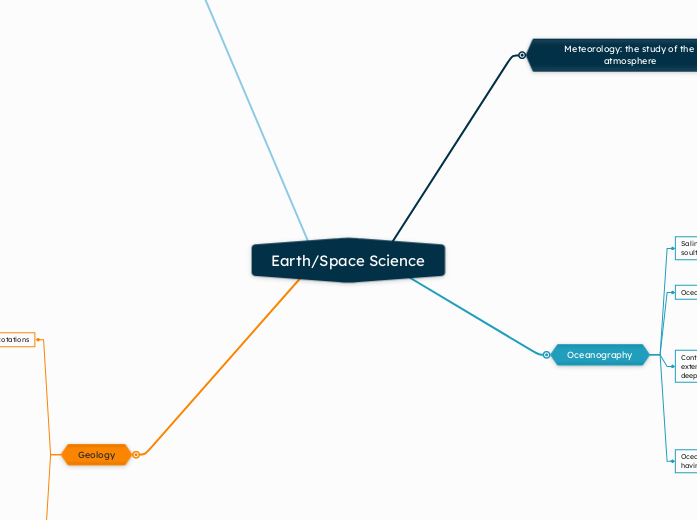Earth/Space Science
Geology
Earth's Structure
Inner Core: innermost part of Earth, made of soil iron and nickel
Outer Core: layer inside Earth, between the mantle and inner core
Mantle: a layer of Earth's surface, lying just below the crust and above the inner core
Crust: outermost, rocky layer of Earth
Weathering: natural gradual process of breaking rocks and other matter into smaller particles called sediment
Volcanoes: hill or mountain formed by material that erupts onto Earth's surface; caused by action of magma below surface
Earthquake: violent shaking of Earth's crust due to energy travelling as waves pass through Earth. Caused by a sudden shift along a fault line, or by volcanic activity
Earth's Rotations
Coriolis effect: effect that Earth's rotation has on the path of air and water moving at or above its surface, causing the fluid's path to curve
Continental Drift: theory stating Earth's continents were once joined in a single large landmass that broke apart, and that the continents have drifted to their current locations.
Plate Tectonics: includes evidence of the continents that have moved and still are moving today
Elevation: the height of land above or below sea level
Longitude: the distance of a place east or west of the prime meridian measured in degrees
Prime Meridian: the central line of longitude and represents 0 degrees longitude. Runs through Western Europe and Africa dividing Earth into an eastern hemisphere and a western hemisphere
Latitude: the distance of a place north or south of the equator measured in degrees
Equator: the central line of latitude, divides the Earth into two halves (north and south hemisphere) represents 0 degrees latitude
Astronomy: study of the planet's, star's, galaxies, and all other objects in space
Objects in the Solar System:
Meteor: a piece of rock from space that enters Earth's atmosphere and burns, creating a bright streak of light across the sky
Comet: solar system object made mostly of ice, which follows a long, narrow orbit around the sun
Asteroids: objects of rock, metal, and ice that are smaller than planets and revolve around the sun
Moon: natural satellite of a plaent. The Earth's moon revolves around Earth once every 27.3 days
Satellite: is an object that stays in an orbit around a planet
Galaxies: group of millions of stars; Earth is part of the Milky Way galaxy
Irregular galaxy: does not have a distinct shape
Elliptical galaxy: shaped like a flattened or partially deflated football
Spiral galaxy: disk-shaped with a bulge in the middle and arms that spiral out from the bulge
Stars: objects in space, made of gases, which produce their own light and heat
Absolute magnitude: a measure of how bright the star really is, if all stars were the same distance from Earth
Apparent magnitude: measure of how bright a star appears to be when you see it from Earth
Light year: measurement equal to 9.5 trillion kilometers, the distance light travels in 1 year
Planet's:
Pluto: neither terrestrial or gas giant, surface made of gases frozen into ice
Gas Giants: surfaces made of slush that form their gaseous atmospheres. Evidence shows their cores are partly iron
Neptune
Uranus
Saturn
Jupiter
Terrestrial planets: rocky surfaces with iron cores
Mars
Earth
Rotation: each complete spin around the axis takes about 24 hours
Axis: imaginary line that runs from its North Pole, through its center, to its South Pole
Venus
Mercury
Oceanography
Ocean life zones: scientists describe the oceans as having three main life zones
Open-ocean zone: ocean life zone reaching from the continental slope to the deepest plains and trenches
Neritic zone: area of sea floor reaching from the shore to the edge of the continental shelf (depth 200 meters)
Intertidal zone: shoreline areas covered by water at high tide and not covered at low tide
Continental Margin: portion of the seafloor extending from the shoreline to the edge of the deep ocean
Continental rise: covered by sediment, where the continental margin levels out
Continental slope: beings where shelf ends and extends 4000 meters deep
Continental shelf: part of cont. margin nearest to shoreline
Ocean currents: flow through the world's oceans
Subsurface: an ocean current flowing beneath the surface, caused mainly by differences in density
Surface: river's of water that move through the ocean's surface
Salinity: (saltiness) amount of dissolved solids in a soultion, such as ocean water
Meteorology: the study of the atmosphere
Ozone: form of oxygen that has three atoms in one molecule
Atmosphere: mixture of gases that surrounds Earth
Weather: conditions of the atmosphere at a particular time and place
Climate: the general weather of an area over a long period of time
Air pressure: measure of the weight of air pressing down on a given area of the Earth's surface
Wind: differences in air pressure
Humidity: moisture in air
Clouds: masses of water droplets or ice crystals that hang in the troposphere over Earth
Air masses: a large body of air that has a certain temperature and amount of moisture
Front: place where two air masses of different temperatures and pressures meet
Layers of atmosphere
Troposphere: lowest layer of Earth's atmosphere, from the surface up to 16 kilometers
Water cycle: continuous movement of water between the surface of Earth and the troposphere
Precipitation: occurs when water or form of ice falls from the atmosphere to Earth's surface
Condensation: the process in which water vapor changes into liquid water
Evaporation: process in which liquid water changes into invisible water vapor
Stratosphere: a layer of Earth's atmosphere reaching from 16-50 kilometers above the surface
Mesosphere: a layer of Earth's atmosphere located between 50-90 kilometers above the surface
Thermosphere: layer of Earth's atmosphere above ionosphere and below exosphere, between 90-300 kilometers
Exosphere: outermost layer of Earth's atmosphere

